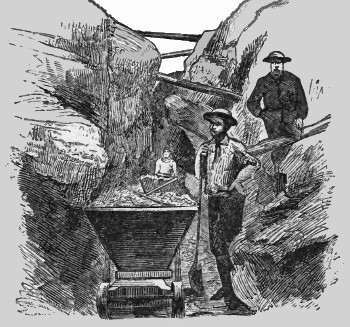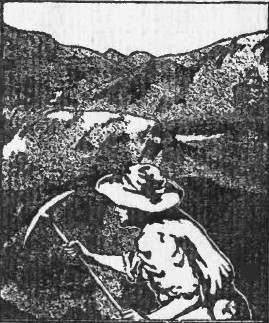Certain results obtained in the treatment of the zinc precipitate in the cyanide works of the Associated Mines have led the mill manager, Mr. Grayson, to deduce the solubility of gold in sulfuric acid when tellurium oxide is also present, and thus to offer a chemical theory for the alleged leaching of gold in the surface ores. This explanation, as it stands, is questionable, because the solubility of gold under the stated conditions is not known. When, however, free chlorine is also present such solubility would occur. The telluric oxide, in the presence of salt and sulfuric acid, would take the part given in the laboratory to the black oxide of manganese. The occurrence, therefore, of waters rich in chlorides, of sulfuric acid derived from decomposing pyrite and of tellurium oxide obtained from the oxidation of calaverite and sylvanite tellurides, are all recognizable amid the conditions at Kalgoorlie, and thus afford a theory which, while it has no very strong evidence to commend it, is at least tenable from a chemical standpoint.
In many cases the supposed enrichment in depth can be easily explained. For example, a shaft passes, in course of sinking, from poor into rich ore. The lode, it would appear, has become better in depth. The fact is, that the shaft was started off the ore shoot, which has a pitch such as to bring it across the line of the shaft at a certain level. It would be just as reasonable to argue that the gold ore occurred in vertical bands because the levels pass in and out of the shoots. In another suggestive instance a vertical shaft was sunk in a very wide lode which is not quite perpendicular. The shaft was started on the hanging wall side, where the ore is now known to be always poor, and in depth it approached the footwall, where the lode is richest. It was assumed, for a time, that a enrichment in depth characterized the lode.
The idea of general enrichment in depth at Kalgoorlie arises from an ignorance of the history of the early development of the region. The discovery of the big ore-bodies was not made in the infancy of the district, but came in the wake of that preliminary digging which usually precedes systematic exploration. Patrick Hannan pegged out the first claim on April 12th, 1892. At that time nothing was known save the existence of a few superficial deposits on the flat overlooked by Cassidy Hill and Mount Charlotte. These deposits were of the kind termed "dry blowers' patches." They may be described as the alluvium of a waterless country. Their substance varies. They may consist merely of a few inches of sand and clay lying on the decomposed rock surface, but elsewhere they may have a thickness of many feet, and include a lower portion which is so compact as to be called "cement." In the absence of the transporting power of running water, the wind has been an active agent in sifting the debris caused by that disintegration of the surface which is mainly traceable to the variation between the heat of day and the cold of night.
The finer rock particles are thus separated from the larger fragments of hard quartz. And although the wind is but a feeble agent as compared with the mountain stream, yet, owing to the prevalence of the constant and violent draughts of a high plateau, such as the interior of West Australia, the sum of its activities during long periods of time is capable of producing noteworthy results. The miner imitates the ways of nature, and in default of sluicing he winnows the dirt by a process known as "dry blowing." The "dry blower" of West Australia is brother to the "gulch miner" of California and the "alluvial digger" of Victoria. From the deposits which are thus accumulated gold has been extensively won, and occasional patches of extreme richness have been encountered. The heaviest gold is found resting close to the underlying rock surface, and therefore, as in ordinary alluvial mining, the working of these deposits often leads to the discovery of the veins from which the gold was shed. Thus many "dry blowers' patches" have been found adjacent to very valuable lodes, and in the case of the alluvium of the Kalgoorlie flats there were found small veins which led to the first mining. This early mining was confined to that portion of the district which is close to the present town of Kalgoorlie, and which is distinct from the scene of the great mining developments of the past two years, 2 miles further to the southward. The veins found in this northern part of the goldfield were, as has been stated, small; they were also uncertain in behavior, and generally poor. They served nevertheless as an excuse for the taking up of numerous leases and the subsequent flotation of mining enterprises of a thoroughly worthless kind. Not one of these veins has as yet become the basis of a successful enterprise, although they have been followed by very extensive workings. In the meanwhile the prospectors wandered further south, and found several rich patches of surface dirt and cement, which led directly to the discovery of one or two strong quartz croppings, on the evidence of which the Great Boulder and other claims now famous were pegged out.
These quartz veins were larger than those previously worked in the northern part of the field, but they were similarly poor and uncertain, although this fact did not prevent the notation of the Great Boulder Proprietary Company. The story of this splendid mine is typical of that of several of its neighbors. The first explorations were confined to a vein which outcropped in the eastern part of the lease, and the shaft sunk upon it is the one known as No. 3, or Gamble North's. The vein was soon proved to be of no importance, becoming thin and poor at a depth of 75 ft. A trench was then started to cut a big ironstone outcrop which forms a hillock behind the present office. This ironstone reef was found to contain only 12 dwt. of gold per ton, an amount too small for profitable operations at that time. When, however, the trench referred to was extended farther west it penetrated another vein which had no outcrop. This proved to be the eastern portion of the magnificent lode which subsequently gave such great value to the mine. It was rich from the start. A wide open cut now bears confirmatory evidence, and the least observant cannot help noticing that the stopes have been extended from the underground workings up to the daylight. The section afforded by the open cut exhibits the fact that 2 ft. of cement form a cap over a lode nearly 20 ft. wide.
The Great Boulder Perseverance had a similar beginning. The first work was done on what is known now as the old No. 1 Shaft, carrying a comparatively poor vein which was abandoned when the rich lode in the neighboring Lake View Consols Mine was traced into the Perseverance ground. This lode, which gave the value to this company's property, also failed to outcrop. A big open cut now explains the reason to be similar to that noted in the case of the Great Boulder. The surface workings on the Ivanhoe, Kalgoorlie, and other adjacent mines exhibit similar conditions, big lodes capped by cement and long lines of stopes breaking through into daylight.
Continue on To:
Minerals Which
Accompany Gold Ores, Part
V


